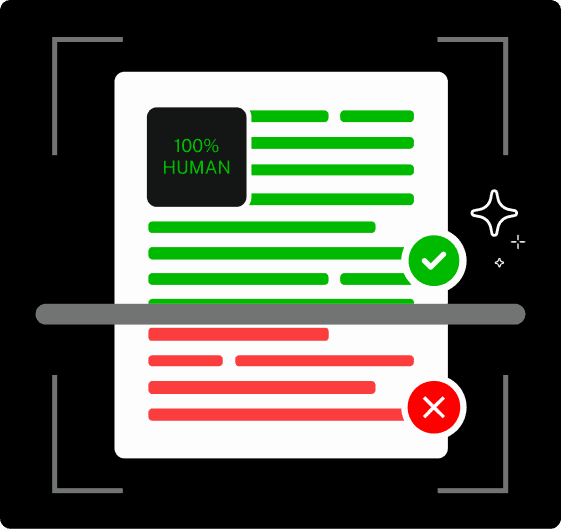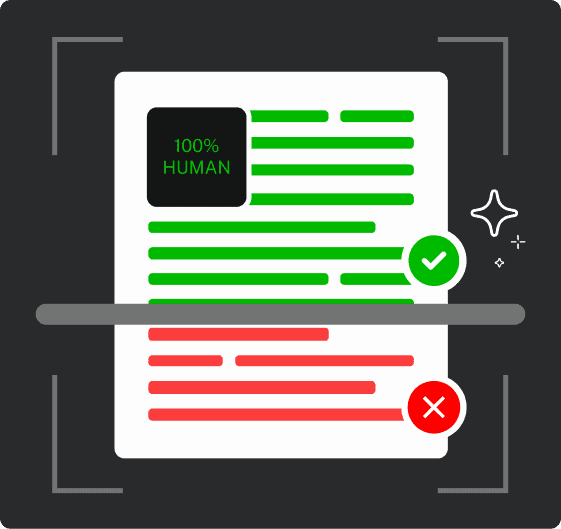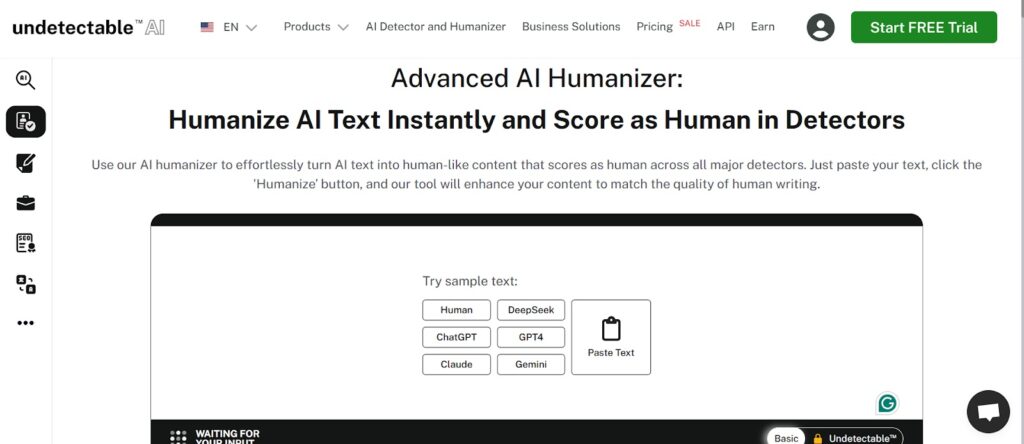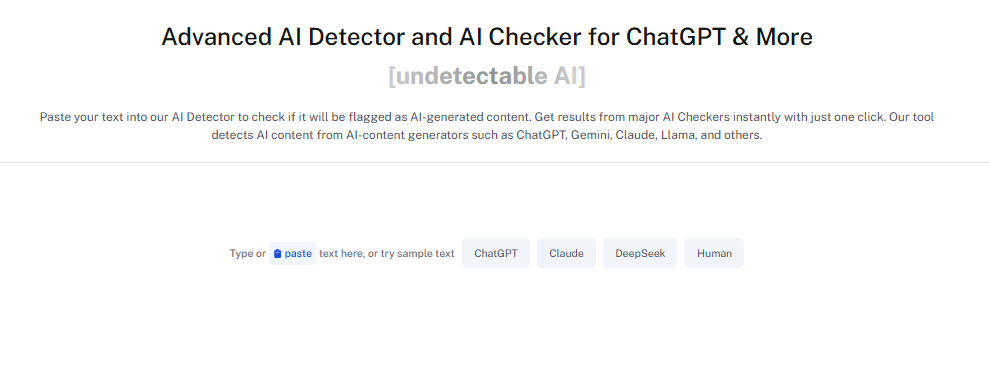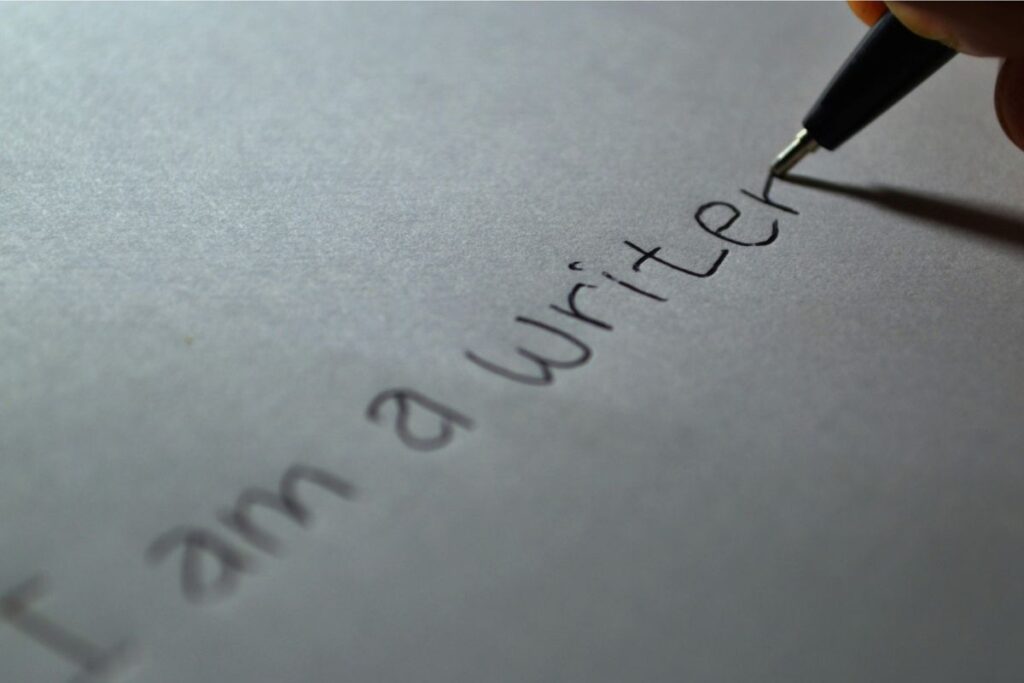In 2025, AI-generated writing is deeply integrated into education, business communication, journalism, and marketing.
As these tools become more accessible and widely adopted, the question becomes increasingly relevant:
Can we accurately distinguish between content written by humans and content that AI creates?
This article explores how AI writing works, how to detect machine-generated content, and the proven strategies and tools that help humanize AI-generated text for more natural, authentic communication.
Let’s begin.
Key Takeaways
- AI-generated content often shows telltale signs like repetitive patterns, over-formal tone, and lack of personal insight, making it easier for detection tools to flag.
- Undetectable AI combines detection and humanization, allowing users to assess and rewrite AI content so it reads naturally and avoids being flagged by detection algorithms.
- Effective detection relies on analyzing tone, accuracy, personalization, and language patterns, with tools and trained eyes spotting inconsistencies AI still struggles to mask.
- Common mistakes in AI writing include keyword stuffing, robotic syntax, and lack of emotional depth, all of which reduce readability and credibility.
- Humanizing AI content involves varied tone, simplified vocabulary, and a touch of creativity, ensuring your writing remains both undetectable and engaging.
What is AI Writing?
AI writing refers to the creation of content by artificial intelligence systems like ChatGPT.
These tools, built with complex algorithms that are fueled by machine learning and natural language processing, are designed to emulate human writing styles by producing texts that are virtually.
But not 100% if you don’t follow the right steps, indistinguishable from human-written content.
Never Worry About AI Detecting Your Texts Again. Undetectable AI Can Help You:
- Make your AI assisted writing appear human-like.
- Bypass all major AI detection tools with just one click.
- Use AI safely and confidently in school and work.
These algorithms are trained on vast datasets to understand and replicate human language patterns, enabling them to produce text that closely mirrors human writing.
The machine-learning process allows AI writers to adapt, refine, and improve their output over time, striving for a level of sophistication that makes the distinction between human and machine-generated content increasingly indistinguishable as time goes on.
The ability and ease with which AI is able to automate content creation tasks not only enhances efficiency but also presents new possibilities for creative collaboration between humans and machines.
How Do AI Writers Work?
AI writing tools operate by using a sophisticated blend of artificial intelligence, machine learning, and natural language processing.
At their essence, these systems undergo extensive training by harnessing diverse datasets and exposing them to vast amounts of text to discern patterns and structures and continually improve their output over time.
The learning process involves understanding grammar, vocabulary, and the intricate nuances of language in the most human form possible.
Neural networks within the AI models continuously refine their understanding through exposure to diverse linguistic contexts and continue improving as people refine their prompts, teaching the tool itself that their first try wasn’t good enough and to keep going.
This adaptability enables AI writers to evolve, improving their output.
Once trained, a process that never actually ends, AI writers employ algorithms to analyze prompts or input and generate text that mirrors the learned patterns.
As of 2025, large language models (LLMs) like GPT-4o and Claude 3 support context-aware, multimodal generation, making it even harder to distinguish AI from human writing.
The continuous learning loop, coupled with the adaptability of neural networks, allows AI writers to produce content that closely resembles texts that were written by people.
As a result, AI writers have become valuable tools in automating content creation, streamlining processes, and boosting human creativity in the professional, personal, and educational worlds.
What are the Challenges of AI Writing?
While AI algorithms have made remarkable strides, they often exhibit subtle differences that can be identified by a trained eye or tool.
One effective method to detect AI writing is by analyzing the tone and style of the text.
AI may struggle to replicate the nuanced variations in expression, humor, or emotional depth that come much more naturally in human communication.
Accuracy, or the lack thereof, is another crucial factor in the detection process.
In specialized or technical content, AI may mistakingly introduce inaccuracies or inconsistencies that make readers suspicious if the article was written by a bot or by a human.
Human writers, with a much more contextual understanding of the subject matter, are able to navigate these intricacies in a more natural way.
AI-generated content often lacks the personal touch found in human writing, such as anecdotes in emails, reflective insights in essays, or brand storytelling nuances.
Simple edits like adding personal experiences, emotions, or subjective nuances into the content are easy for people but pose a major challenge for algorithms that are still learning to write like people.
Human writers naturally include a genuine touch in their storytelling, a quality often absent in AI-generated content, at least for now.
Can AI content be detected?
Detecting AI writing involves a close examination of tone, accuracy, personal touch, language patterns, and other factors that still distinguish AI-written content from human content.
As technology advances, the nuances that differentiate human and AI writing may become subtler, making the detection process an evolving challenge.
But now, it is still very easy, especially for tools and detection algorithms, to spot the difference.
One simple and very basic approach to detecting articles that are written by bots is by analyzing the overall tone and style of the content itself.
AI may struggle to replicate the humor or emotional depth that is common in human communication. This makes a detection tool flag the content by seeing that something is off with the writing.
The lack of a personal touch, the presence of repetitive language patterns, and a potential overemphasis on keywords (a lot of times used by SEO writers to try and rank content in Google faster) are additional red flags that can stand out while trying to distinguish AI-generated content from articles written by people.
How to detect AI-generated text?
Identifying AI-generated text involves taking into consideration all of these subtle factors and creating tools and detectors that instantly compare them to machine-learned patterns that will expose the robot from the person.
To assist with this process, several tools have emerged that analyze these patterns and help users evaluate whether content is AI-generated.
This 2025 guide to the best AI detector tools provides an up-to-date overview of the most effective platforms available today.
Differences in tone and style, particularly the nuanced variations in human expression, can be revealing. Inaccuracies in specialized content and the absence of a personal touch may indicate AI origin.
Repetitive language patterns and an overemphasis on keywords are additional markers.
- Tone and Style Analysis: Evaluate the consistency and natural flow of the text.
- Accuracy Checks: Verify factual information and context relevance.
- Personalization Indicators: Look for personal anecdotes or subjective insights.
- Repetitive Language Patterns: Identify overused phrases or structures.
Example: Compare a human-written paragraph with an AI-generated version to observe differences in tone, variation, and personalization.
Use Undetectable AI
One of its most powerful features is the Humanizer Tool, which rewrites AI-generated text to sound more authentic, natural, and contextually aware.
It allows users to fine-tune tone, formality, and purpose to create content that resonates more closely with human writing.
Using Undetectable AI enhances AI-written content by humanizing it in ways that will make it read better and pass detection tool tests.
The AI detection tool employs advanced algorithms and linguistic models to seamlessly integrate AI-generated text with human-created content, making detection by algorithms and tools nearly impossible.
By leveraging Undetectable AI, users can confidently use AI-generated content across various platforms without the risk of getting flagged by detection tools or penalized by algorithms.
Its unique approach ensures that AI writing not only meets grammatical standards but also mirrors the varied and, at times nuanced, aspects of human expression while addressing common challenges and problems that were discussed earlier with AI-written texts.
As of 2025, Undetectable AI offers advanced features that enhance the human-like quality of AI-generated content, ensuring it meets current standards for authenticity and readability.
Before you rewrite, you can also use the AI Detection Checker to evaluate how detectable your content is. The tool provides real-time insight on whether your text might raise red flags and recommends edits to reduce its AI signature.
What are the signs that a text was generated by AI?
Identifying AI-generated text involves a deep understanding and observation of distinct signs that set it apart from content written by people.
Too much precision, for example, is a common red flag; AI can exhibit unnatural accuracy in data, statistics, or technical details of the subject matter.
Overly formal language is another red flag, as AI tends to default to a more professional tone, lacking the casual tone and writing style more common in human communication.
Consistency across genres can also reveal AI origin, as it may struggle to adapt its style appropriately to different content types, niches, and topics.
A particularly distinctive sign is the absence of genuine experience or situational context—elements that humans instinctively incorporate, and AI still struggles to replicate.
AI usually struggles to insert personal experiences and emotions into text and that leads to a severe and noticeable lack of genuine human connection.
What are the common mistakes in AI-generated text?
AI-generated text, while increasingly sophisticated, is far from immune to common mistakes that can be flagged through some careful analysis.
One common issue is a lack of coherence in the copy. AI can produce articles and texts that lack logical flow and fail to connect ideas in a natural way.
Overemphasis on keywords is also a common mistake, where AI may prioritize certain terms, compromising the natural flow of the text and endangering the article of being flagged by algorithms seeking to punish writers employing black hat SEO tactics and keyword stuffing.
Despite these challenges, it’s still a very new area that’s improving quickly with ongoing developments that aim to resolve these issues and make AI-written texts more and more human.
Which AI writing tool can’t be detected?
Among the many AI writing and detection tools available on the market, Undetectable.ai stands out as the most trusted solution designed so your AI-generated content avoids detection.
By addressing common red flags that are found in most AI-written texts – such as tone issues, accuracy challenges, lack of personal touch, and repetitive language.
Undetectable AI sets a new standard for the crossroads of artificial intelligence and human creativity, making it exceptionally challenging to know whether or not a piece of content was written by a machine or a human.
How do I make AI writing undetectable?
Making AI writing truly undetectable involves a multifaceted and creative approach that connects the precision of algorithms and machine learning with the natural and unmistakable touch of human creativity.
Human editors bring a much-needed understanding of cultural context, idiomatic expressions, and subjective subtleties to polish and authenticate content in ways that will please readers while avoiding detection from tools and algorithms.
Purposely varying the tone and style helps bridge the gap between the robotic precision of AI and the natural expression that comes from human writing.
Deliberately infusing content with changes in tone, formality, or humor makes the resulting text far more undetectable and natural in style.
As technology continues to improve, these strategies will continually evolve, offering a must-have in the arsenal of any content creator.
Join thousands of professionals using our AI Detector and Humanizer—available below.
Conclusion
The world of AI writing is rapidly evolving, offering both exciting opportunities and real challenges.
As human creativity intersects with artificial intelligence, we’re entering an era where collaboration between the two can elevate content creation like never before.
By embracing tools that create undetectable AI content, we can boost productivity in work and education—while preserving the human voice that makes communication meaningful.
It’s not just about speed; it’s about blending precision with personality.
Ready to bridge the gap between AI efficiency and human authenticity? Try Undetectable AI today.

